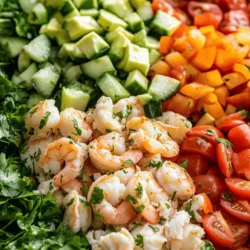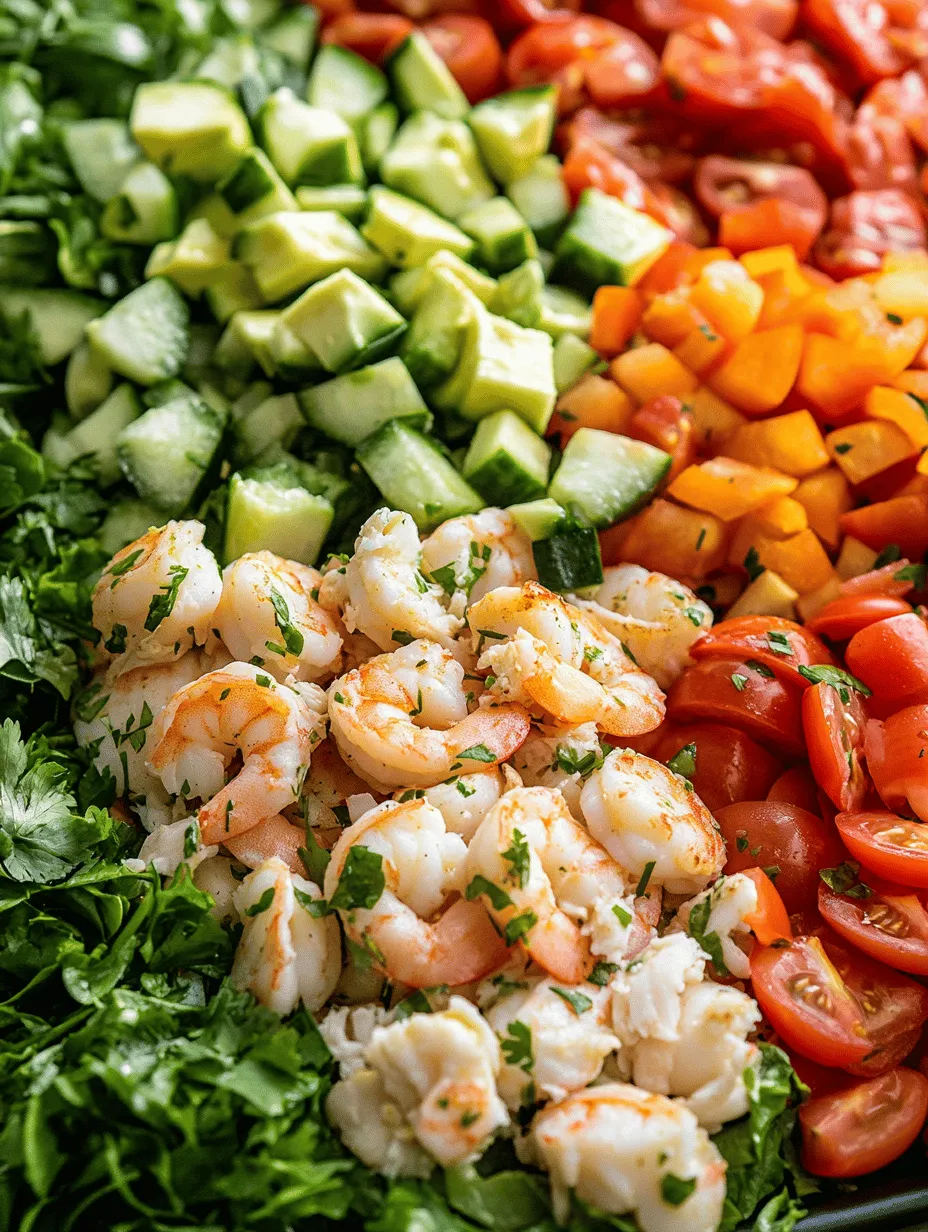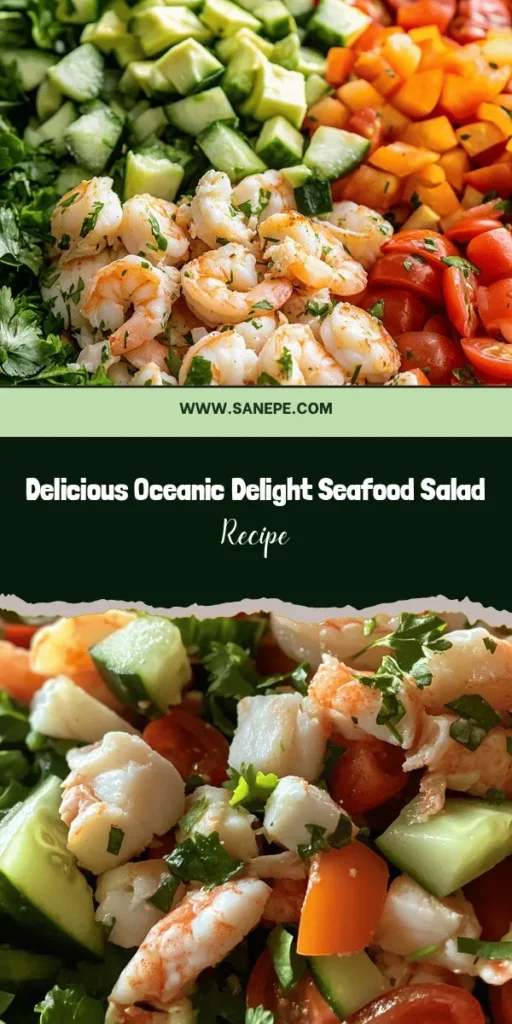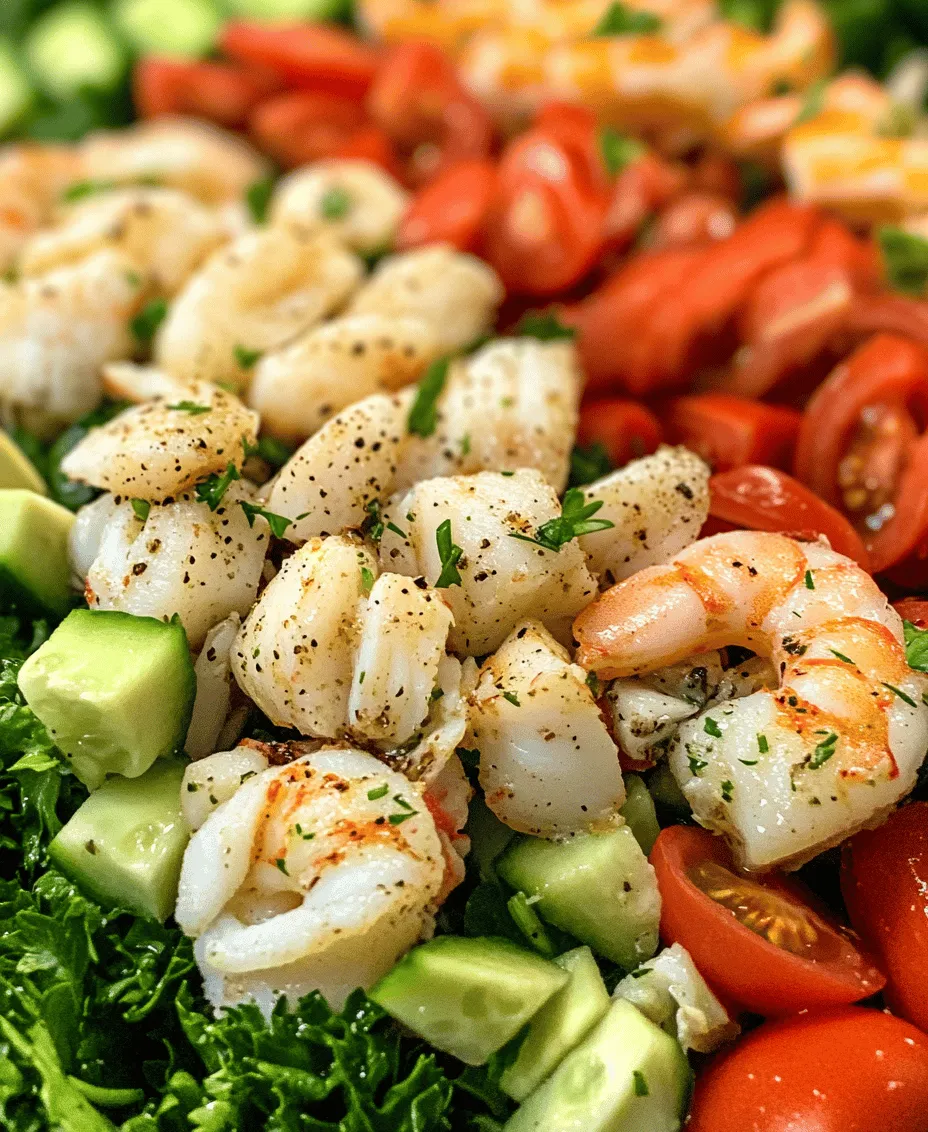Introduction
Are you searching for a dish that embodies the freshness of the ocean while offering a delightful blend of flavors and textures? Look no further than the Oceanic Delight: Fresh Seafood Salad. This vibrant and nutritious salad combines a medley of seafood with crisp vegetables, making it the perfect choice for a light lunch or an elegant dinner. Whether enjoyed on a sunny day or as a refreshing appetizer, this salad is sure to impress.
Seafood is not just delicious; it’s also an essential part of a balanced diet. Rich in omega-3 fatty acids, protein, and a variety of vitamins and minerals, seafood plays a crucial role in promoting heart health, reducing inflammation, and supporting brain function. This dish showcases the best of what the ocean has to offer, providing all these health benefits in a single bowl.
In this article, we aim to guide you through the preparation of the Oceanic Delight Seafood Salad, highlighting the health benefits of its ingredients and providing step-by-step instructions for creating this delectable dish. Let’s dive into the world of flavors and nutrition!
Understanding the Ingredients
The beauty of the Oceanic Delight Seafood Salad lies in its fresh ingredients, each contributing to the overall taste and nutritional profile. Here’s a closer look at the key seafood components and other ingredients that make this salad a standout dish.
Key Seafood Components
1. Cooked Shrimp: Shrimp is a star ingredient in this salad, known for its succulent texture and sweet flavor. Nutritionally, shrimp is low in calories yet high in protein, making it an excellent choice for those looking to maintain or lose weight. Additionally, shrimp contains selenium, which is essential for thyroid health and plays a role in DNA synthesis.
2. Cooked Crab Meat: Another highlight of this seafood salad is crab meat. This delicacy is not only a source of high-quality protein but also packed with vitamins such as B12 and minerals like zinc and copper. Crab meat adds a tender, sweet taste that complements the other seafood perfectly.
3. Scallops: Scallops are a low-calorie seafood option that boasts a high protein content. They are rich in vitamins B12 and B6, which contribute to energy metabolism and brain health. Scallops also have a slightly sweet, buttery flavor that elevates the overall taste of the salad.
Fresh Vegetables in the Salad
To create a well-rounded seafood salad, it’s vital to include a variety of fresh vegetables that not only enhance flavor but also increase the nutritional value of the dish. Here are the key vegetables featured in the Oceanic Delight:
1. Mixed Greens: A blend of arugula and spinach serves as the base for this salad. Arugula is rich in vitamins A, C, and K, while spinach is known for its iron and calcium content. Together, they provide a nutritious foundation that adds a peppery taste and vibrant color.
2. Cherry Tomatoes: These bite-sized tomatoes are not just visually appealing; they also pack a punch of flavor and nutrition. Cherry tomatoes are rich in antioxidants like lycopene, which can help reduce the risk of chronic diseases. They add a juicy sweetness to the salad that balances the seafood’s flavors.
3. Red Onion: The sharpness of red onion adds depth to the salad. Red onions are a good source of quercetin, a powerful antioxidant with anti-inflammatory properties. Their vibrant color and crunch contribute to the overall texture of the dish.
4. Cucumber: Cucumber adds a refreshing crunch to the salad while being low in calories. It provides hydration, vitamins K and C, and a subtle sweetness that complements the other ingredients.
5. Bell Peppers: Bell peppers, especially the red and yellow varieties, are rich in vitamins A and C. Their sweetness and crunch enhance the salad’s texture and add a beautiful splash of color.
The Role of Avocado
No seafood salad is complete without the creamy richness of avocado. Avocado is packed with healthy monounsaturated fats, which are known for their heart health benefits. They also help in absorbing fat-soluble vitamins from the salad’s other ingredients. The creamy texture of avocado enhances the overall mouthfeel of the dish, making each bite a delightful experience.
Preparation of Oceanic Delight
Now that we’ve reviewed the essential ingredients of the Oceanic Delight Seafood Salad, it’s time to prepare it. Follow this step-by-step guide to create your own delicious seafood salad, ensuring you handle the seafood safely and effectively.
Step-by-Step Guide to Preparing the Seafood Salad
1. Gather Your Ingredients: Before you begin, ensure all your ingredients are fresh and ready to use. This includes your seafood, mixed greens, vegetables, and any additional herbs or spices you may want to add.
2. Handling the Seafood: If you’re using frozen seafood, be sure to thaw it completely before cooking. Rinse the shrimp, crab meat, and scallops under cold water to remove any excess salt or ice crystals. Ensure that you pat them dry with a paper towel to avoid excess moisture in the salad.
3. Cooking the Seafood:
– For the shrimp, bring a pot of water to a boil, adding a pinch of salt. Add the shrimp and cook for 2-3 minutes, or until they turn pink and opaque. Remove them from the pot and place them in an ice bath to stop the cooking process. Drain and set aside.
– For the scallops, heat a non-stick skillet over medium-high heat. Add a drizzle of olive oil and sear the scallops for about 2-3 minutes on each side until they are golden brown and opaque in the center. Remove from heat and let them cool.
– If using canned crab meat, simply drain it and ensure no shells are present.
4. Chop the Vegetables: While the seafood is cooling, chop your vegetables. Dice the cucumber, halve the cherry tomatoes, thinly slice the red onion, and chop the bell pepper. Combine these in a large mixing bowl along with the mixed greens.
5. Combining the Seafood: Once the seafood has cooled, gently fold the cooked shrimp, crab meat, and scallops into the bowl of vegetables. Be careful not to break the seafood apart; you want to maintain the integrity of the ingredients.
Making the Vinaigrette
A delicious vinaigrette is essential for dressing the Oceanic Delight Seafood Salad. The right dressing not only enhances the flavor but also ties all the ingredients together.
1. Ingredients for the Vinaigrette:
– 1/4 cup olive oil
– 2 tablespoons lemon juice (freshly squeezed)
– 1 tablespoon Dijon mustard
– 1 teaspoon honey or maple syrup (optional for a hint of sweetness)
– Salt and pepper to taste
2. Emulsification Explained: To create a smooth vinaigrette, you will need to emulsify the ingredients. In a small bowl or jar, combine the lemon juice, Dijon mustard, and honey (if using). Whisk or shake until well combined. Slowly drizzle in the olive oil while continuing to whisk or shake vigorously. This process helps to blend the oil and vinegar, creating a creamy dressing that adheres beautifully to the salad.
3. Tossing the Salad: Drizzle the vinaigrette over the seafood and vegetable mixture. Gently toss everything together, ensuring that the dressing evenly coats all the ingredients. Adjust seasoning with salt and pepper to taste.
By following these steps, you will create a delicious and refreshing Oceanic Delight Seafood Salad that highlights the best flavors of the ocean and the garden. This dish not only provides a burst of flavors but also serves as a nutritious meal option that supports a healthy lifestyle. Stay tuned for the next part of the article, where we will explore tips for achieving the best results and answer some common questions about this delightful seafood salad.
Adding Vegetables: Balancing Flavors and Textures
In crafting the perfect seafood salad, the addition of vegetables plays a pivotal role in achieving a harmonious balance of flavors and textures. Fresh vegetables not only contribute vibrant color to the dish but also enhance the overall taste and nutritional profile. When selecting vegetables, consider a variety of textures and flavors that can complement the delicate nature of the seafood.
Start with crisp greens such as romaine lettuce or arugula, which provide a refreshing crunch. Add diced cucumbers for a hydrating element, and cherry tomatoes for a burst of sweetness. Bell peppers, with their vibrant colors and slight sweetness, can be sliced thinly or diced to add both texture and visual appeal. Avocado is another excellent choice, lending creaminess to the salad while also providing healthy fats.
When incorporating these vegetables, aim for a balanced mix that allows the seafood to shine. A light drizzle of olive oil and a squeeze of lemon juice can help meld the flavors together, ensuring that each bite delivers a delightful combination of seafood and fresh produce. The goal is to create a refreshing and satisfying dish that not only nourishes but also excites the palate.
Importance of Allowing Flavors to Meld
Once your seafood salad is assembled, allowing the flavors to meld is essential for achieving a cohesive taste. This process, often referred to as “marinating,” involves letting the ingredients sit together for a short period, enabling the flavors to intermingle. Ideally, letting the salad rest for about 20 to 30 minutes at room temperature—or even longer in the refrigerator—will enhance the overall flavor profile.
During this time, the seafood absorbs the tangy notes from the dressing, while the vegetables release their natural juices, contributing to a more flavorful and juicy salad. This melding process not only improves the taste but also enhances the overall experience for those enjoying the dish. Just be cautious not to let seafood sit too long in acidic dressings, as it can begin to “cook” and alter the texture of the seafood.
Flavor Profiles and How They Enhance the Dish
Understanding flavor profiles is crucial for any culinary endeavor, and seafood salad is no exception. The combination of salty, sweet, sour, and umami flavors creates depth and complexity, making each bite more enjoyable. The primary flavor profile in a seafood salad often includes the natural brininess of the seafood, which can be balanced with acidic elements like lemon juice or vinegar.
The sweetness of vegetables such as bell peppers and tomatoes adds another layer of complexity. Fresh herbs like dill, parsley, or cilantro introduce a fragrant note, enhancing the dish and complementing the seafood beautifully. Consider adding a touch of spice with red pepper flakes or black pepper to elevate the dish further, providing a gentle warmth that enhances the overall flavor without overpowering the delicate seafood.
Health Benefits of Seafood
Seafood is not only delicious but also boasts numerous health benefits that make it an excellent choice for anyone looking to maintain a balanced diet. Here’s a detailed analysis of how seafood can enhance your health:
Heart Health: Omega-3 Fatty Acids and Cholesterol Levels
One of the most significant benefits of seafood is its rich content of omega-3 fatty acids, particularly found in fatty fish like salmon, mackerel, and sardines. These essential fats are known for their ability to reduce inflammation and lower the risk of heart disease. Incorporating seafood into your diet can help maintain healthy cholesterol levels by increasing high-density lipoprotein (HDL) cholesterol, which helps remove excess cholesterol from the bloodstream.
Brain Health: Nutrients That Support Cognitive Function
Seafood is also a powerhouse for brain health. Omega-3 fatty acids are crucial for cognitive function, and studies have shown that regular consumption of fish can reduce the risk of cognitive decline as we age. The presence of DHA (docosahexaenoic acid), a type of omega-3, is particularly important for maintaining healthy brain function and may even play a role in reducing the risk of neurodegenerative diseases such as Alzheimer’s.
Weight Management: Low-Calorie, High-Protein Benefits
For those looking to manage their weight, seafood is an excellent protein source that is low in calories yet high in essential nutrients. This makes it a suitable option for anyone seeking to maintain or lose weight while still feeling full and satisfied. The high protein content found in seafood helps promote muscle growth and repair, contributing to overall health and wellness.
Comparison with Other Protein Sources
When compared to other protein sources, seafood stands out for its nutritional value. While red meat and processed meats can be high in saturated fats and calories, seafood typically contains less fat and fewer calories, making it a more healthful alternative. Additionally, seafood is often rich in vitamins and minerals such as selenium, iodine, and vitamin B12, which are vital for various bodily functions.
Serving Suggestions
To truly elevate your Oceanic Delight seafood salad, consider these serving suggestions that enhance both presentation and flavor.
Presentation Tips for a Visually Appealing Dish
A visually appealing presentation can make your seafood salad even more enticing. Start by arranging the salad in a large, shallow bowl or on a platter to showcase the vibrant colors of the ingredients. Layer the greens as a base, then artfully arrange the seafood and vegetables on top. Garnish with fresh herbs or edible flowers for an elegant touch. Drizzling a light vinaigrette over the top just before serving can add a glossy finish that enhances the overall aesthetic.
Pairing Options: Side Dishes or Drinks That Complement the Salad
To round out your meal, consider pairing your seafood salad with complementary side dishes. A light, crusty baguette or whole-grain crackers can provide a satisfying crunch without overwhelming the delicate flavors of the salad. For a refreshing beverage, consider serving chilled white wine, such as a Sauvignon Blanc or Pinot Grigio, which pairs beautifully with seafood. Alternatively, a sparkling water infused with lemon or lime can offer a refreshing non-alcoholic option.
Variations on the Salad: Alternative Seafood Options and Seasonings
The versatility of seafood allows for numerous variations on this salad. While shrimp, scallops, and crab are popular choices, feel free to experiment with different types of seafood. Grilled octopus, smoked salmon, or even canned tuna can add unique flavors to your dish. Additionally, consider a variety of seasonings or dressings to personalize the salad further. A zesty citrus vinaigrette, a creamy avocado dressing, or even a spicy sriracha mayo can dramatically change the flavor profile, allowing you to create a dish that suits your personal taste.
Culinary Insights
Understanding the culinary context of seafood salads can enhance your appreciation for this dish.
Historical Context of Seafood Salads in Different Cuisines
Seafood salads have a rich history across various cultures, often reflecting regional ingredients and culinary traditions. In Mediterranean cuisine, for example, seafood salads are a staple, showcasing the freshness of the sea paired with vibrant vegetables and olive oil. Similarly, in Asian cuisines, seafood salads often incorporate unique ingredients like sesame oil, ginger, and soy sauce, creating an entirely different flavor experience.
Regional Variations: How This Dish Can Be Adapted Globally
The beauty of seafood salad lies in its adaptability. In Latin American countries, ceviche—a dish made from raw fish marinated in citrus juice—offers a fresh and zesty take on seafood salad. In Southeast Asia, salads may incorporate spicy elements and ingredients like fish sauce, lime, and fresh herbs, creating bold and invigorating flavors. Each region brings its own unique twist to seafood salads, making it a dish that can be enjoyed worldwide.
The Art of Balancing Flavors in Salads
Mastering the art of flavor balancing is essential when creating any salad. Pay attention to the primary flavors in your ingredients and aim for a blend that complements rather than competes. When crafting your seafood salad, consider the balance of salty, sweet, sour, and bitter notes. Adjust the seasoning as necessary, using acidic ingredients to cut through richness and adding herbs or spices to enhance the overall flavor profile.
Conclusion
The Oceanic Delight seafood salad is not just a meal; it is a celebration of flavors, textures, and health benefits. Packed with omega-3 fatty acids, lean proteins, and vibrant vegetables, this dish offers a refreshing and nourishing option for any occasion. Whether served as a light lunch, a stunning appetizer, or a main course, it showcases the versatility of seafood in a way that is both satisfying and healthful.
We encourage you to try this recipe for a refreshing meal that is as beautiful as it is delicious. With its balance of flavors and nutritional benefits, seafood salads make an excellent addition to a balanced diet, allowing you to enjoy the bounty of the ocean while nourishing your body. Embrace the versatility of seafood salads and explore the myriad ways to incorporate this delightful dish into your culinary repertoire.



